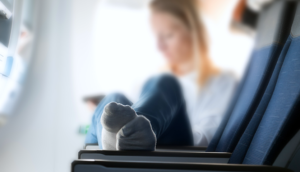How to walk. How to dress. The most effective way to throw a phone. When it comes to life lessons, there’s plenty to be learned from British supermodel and frequent flyer, Naomi Campbell. But the most unlikely and certainly most important lesson for travelers? That would be how to properly clean an airplane seat. Campbell went viral after posting her pre-flight sanitation spree to YouTube last summer. In it, she gleefully talks viewers through her process while scrubbing down any nearby surface that could brush against her mid-flight.
What Naomi knows, and what endless studies have confirmed, is that airplane seats are shockingly filthy places. An analysis by the Canadian Broadcasting Corporation found airplane seat headrests to be the most contaminated surface on an airplane, even testing positive for traces of E. coli.
Related: The Travel Insurance You Need to Buy and the Kind You May Already Have
The Dirtiest Places on an Airplane
The results are just as dismal for tray tables, seatback pockets, air vents, and other airplane surfaces that rarely if ever get cleaned. While the average household toilet may contain around 30 colony forming units (CFUs) of bacteria, an airplane tray table swab turned up 11,595 CFUs in a 2018 study. Strains of bacteria responsible for strep throat and staph have also been found on airplane surfaces.
Antibacterial Wipes for Airplanes
If this all sounds like something you’d rather avoid, take a tip from Mother Naomi. Always bring antibacterial wipes in your carry-on, and always wipe down surfaces around your seat. It’s your best defense against getting sick and ruining your trip.
Travel-sized surface wipes are easily found online from brands like Clorox and Lysol, and in an array of scents. If you’re concerned with assaulting your seatmate with wafts of lemony bleach, go for something more clinical with these medical-grade SONO disinfecting wipes.
As many of the product reviews note, it’s important to allow surfaces time to properly dry after you wipe it down. “Although our wipes have a four minute contact time, we recommend letting the device sit for at least 10 minutes before wiping off the residue left behind..,” explains a SONO rep. “This will ensure that all the EPA registered pathogens are killed and removed.”
Related: The Germiest Thing at the Airport You'll Probably Want to Stop Touching
Seatback Pockets Have More Germs Than You Think
Reaching your hand into the bacterial abyss of a seatback pocket is on par with using a gas station toilet for a finger bowl. Both are something to be avoided at all costs. Passengers have been known to stash dirty diapers, snotty tissues, and used sick bags in seatback pockets, and you can be sure the airlines aren't thoroughly cleaning these things between flights.
If you’re the type of flyer who needs a place to store a water bottle or phone mid-flight, consider taking along a hanging airplane seat organizer that can hook on the seat in front of you. Many are sold in sets that also include tray table covers. Another bonus of using your own hanging caddy is you won't have to worry about losing items to the seatback pocket anymore.
Airplane Seat Covers and Travel Blankets
Speaking of your seat, you’re pretty limited in what you can do in terms of cleaning the upholstery itself. If your worry level is tilting towards Howard Hughes germaphobe, there are seat covers made especially for airplanes. You might get some looks from your fellow seatmates, but who cares what they think? As Naomi says, it's your health. But for the sake of your carbon footprint, skip the disposable airplane seat covers for something more eco-friendly or washable.
Again, Naomi has the right idea by bringing her own travel blanket to drape over the seat. Choose something soft and plush, like a microfleece travel blanket, and give your seat a little extra cushioning while you’re at it. Plus, it’s washable, so you can use it again and again.
Whatever you do, resist the temptation to use the airline-provided blanket. It may be wrapped in plastic, but that doesn't mean it's clean. On average, airlines clean their blankets every five to 30 days, so there's a very good chance yours has been pre-cuddled (or worse) several times over by the time it gets to you.
Seriously, Don’t Forget the Hand Sanitizer
Congrats! Now your little slice of the aircraft is clean and germ-free! The bad news? At some point, you’ll probably have to venture down the aisle and into–gulp!–the lavatory. Unless you have an open hydrant of bleach at your disposal, there’s no way you can disinfect that whole mess of a bathroom. Instead, go bananas with the hand sanitizer. Most come in travel sizes that meet TSA liquid requirements, or you opt for a sanitizing wipe that's safe to use on hands. Just don't sanitize before having to balance yourself on all those germy headrests as you navigate the aisle.
Stay on top of breaking sales, fare drops, and more! Follow us on Twitter @Airfarewatchdog. And make sure to sign up for FREE airfare alerts to be notified when prices drop.






